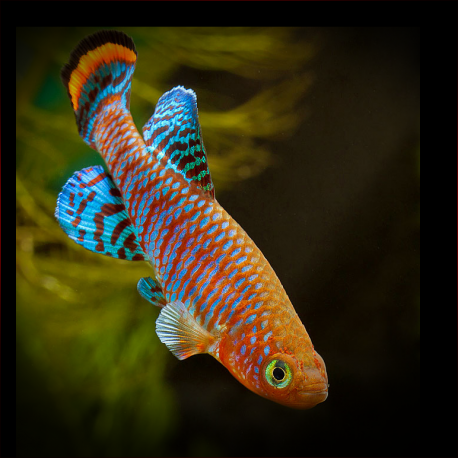More info
Datasheet
| Minimum Tank Size | 40 litres / 10.57 US gallons |
| Maximum Size | 5.5cm / 2.17inches |
| Temperature | 20°C / 68.00°F - 24°C / 75.20°F |
| Hardness | 3.03dgH / 54ppm - 10.03dgH / 179ppm |
| pH | 6.0-7.5 |
General Description
The Bluefin Nothobranch, scientifically known as Nothobranchius Rachovii, is a member of the Nothobranchiidae family within the Cyprinodontiformes order. These aplocheiloid-toothcarps are relatively small, reaching a maximum size of 5.5cm, with males being larger and more colorful than females.
Aquarium Setup
To house Bluefin Nothobranch, an aquarium with a minimum size of 40 liters is recommended, with water conditions set at a pH of 6.0-7.5, a hardness of 54-179ppm, and a temperature range of 20-24°C. While peat moss is commonly utilized as a spawning medium, the species itself does not necessitate peat in the tank setup.
Behaviour
In their natural habitat, these fish face seasonal environmental changes, leading to a unique reproduction strategy where fertilized eggs endure drought conditions until the return of the rainy season. Within an aquarium, their lifespan typically ranges from 6 to 12 months, with males exhibiting more vibrant colors and larger size compared to females.
Feeding and Diet
Bluefin Nothobranch are micropredators, preferring small live or frozen foods like Daphnia, Artemia, and chopped bloodworms. This diet mirrors their natural feeding habits and helps to maintain their health and vibrancy in a captive environment.
Reproduction & Dimorphism
Reproduction in Bluefin Nothobranch involves the deposition of fertilized eggs in the substrate during dry seasons, which hatch when the rains return after about 5-6 months. Males also differ significantly from females in size and coloration, showcasing a notable sexual dimorphism within the species.
Habitat and Distribution
These fish originate from areas near Beira, Mozambique, with specific subpopulations identified as N. pienaari and N. krysanovi in different regions. Their habitat includes ephemeral water bodies in lowland floodplains with a pH range of 6.0-7.0, characterized by seasonal water level fluctuations and the presence of various aquatic plant species.

